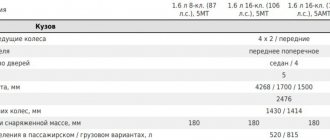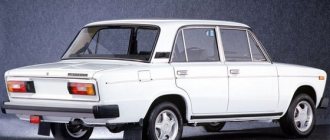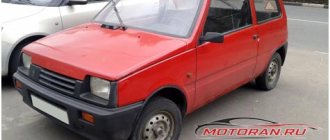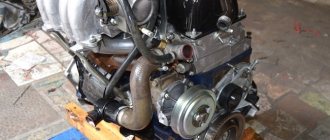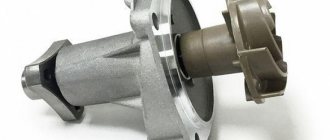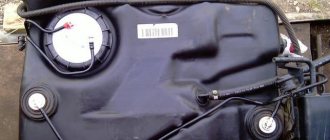The UAZ 469 all-terrain vehicle, which appeared in our country in the early 70s of the twentieth century, remained for a long time the best domestic SUV. Thanks to its high reliability, maintainability in field conditions and low price, this machine still remains the standard all-wheel drive vehicle for many.
In 1974, the car passed a serious test - the conquest of the Elbrus region. Having passed an altitude of about 4000 m above sea level, it became the only vehicle to overcome this height without the help of special equipment.
The disadvantages of the UAZ 469 are a tarpaulin awning instead of a roof and a weak stove. But they are more than compensated by the vehicle's cross-country ability.
In 1985, the car was renamed UAZ-3151. Modifications 31514 and 31514-010, equipped with spring suspension, also appeared on sale. In 2003, a more modern version was released, replacing “469” - “Hunter”. The total volume of their production in 2007 was 2 million copies. By this time, an anniversary modification of the car had been released - with a 2.7 liter engine and a power of 128 hp.
Let's look at how the cooling system of the UAZ 469 is designed, what is the principle of its operation, how much antifreeze it holds, and why the coolant can overheat.
Basic characteristics of the body and engine
Brief description of the UAZ 469 (469B):
- body – steel, open;
- type – frame convertible station wagon;
- number of places – 7;
- number of doors – 5;
- length – 4025 mm;
- width – 1805 (1785) mm;
- height – 2050 (2015) mm;
- base – 2380 mm;
- ground clearance – 300 (220) mm;
- weight without load – 1600 (1540) kg;
- weight with full load – 2400 (2280) kg;
- fuel tank volume – 78 liters;
- maximum speed – 90 (120) km/h;
- ford depth – 0.7 m;
- maximum climbable height with driver and 1 passenger – 57°;
- the maximum climbable height at full load is 31°.
Since the start of production, the UMZ 414 engine has been installed on the civilian modification of the SUV.
Military models were equipped with the same power unit, but with a pre-heater, so the motor has a different index - UMZ 41416.
Engine specifications:
- type – gasoline, atmospheric, 4-stroke;
- number of cylinders – 4;
- arrangement – in-line, vertical;
- operating order – 1-2-4-3;
- cylinder diameter – 92 mm;
- piston stroke – 92 mm;
- engine displacement – 2.5 l;
- compression ratio – 6.7;
- power – 75 l. With.;
- maximum torque – 167 Nm;
- average gasoline consumption on the highway – 10.75 liters per 100 km;
- maximum off-road gasoline consumption – 17.25 liters per 100 km;
- weight of the UMZ 414 engine with attachments and clutch, but without fluids – 163 kg;
- weight of UMZ 41416 with canopies and clutch, but without fluids - 165 kg;
- coolant volume (coolant) – 13 l;
- operating coolant temperature – 80-90°C;
- engine oil volume in the cylinder block – 5.8 l;
- normal oil pressure at idle – 0.5-0.8 kg/cm³;
- normal oil pressure at speed is 2-5 kg/cm³.
Under the hood of the 469 model
Operating principle
When the engine is cold, the thermostat is closed and coolant does not circulate through the lines and pipes. When the power unit starts, the pump pushes antifreeze into a small circle - through the water jacket and the pump.
When the coolant temperature reaches +70 °C, the thermostat located in the radiator outlet pipe opens automatically. The coolant rushes from the water jacket into the radiator and begins to flow in a large circle. At the same time, it is additionally cooled by the counter flow of air and a fan installed in front of the radiator.
This happens in the summer heat. In winter, the thermostat may not open even when the car is used around the clock. The reason is that the ambient temperature does not allow the antifreeze to heat above +60 °C (before normal engine operation).
Scheme
- The length of the car is 4025 mm.
- The width of the car is 1785 mm.
- The height of the UAZ is 2015 mm.
- Ground clearance or clearance – 300 mm.
- The wheelbase of the car is 2380 mm.
- Rear track – 1442 mm.
- Front track – 1442 mm.
- UAZ weight 469 - 1650 kg - curb weight of the UAZ, 2450 kg - total vehicle weight.
- The vehicle's carrying capacity is 800 kg.
Cabin
Which oil to choose
To fill axle housings, it is necessary to use a substance with a viscosity of SAE 75W-90, which corresponds to API GL-5. The plant does not provide for the use of summer and winter oil; the refilled semi-synthetic type fluid protects surfaces from wear at temperatures from -25°C.
If you plan to operate the car at low air temperatures, it is recommended to fill the axles with synthetic oil that is resistant to thickening in the cold. It creates additional resistance to movement in the axle housings, although it negatively affects fuel consumption.
Recommended grades of oil for UAZ Patriot axles:
- Fully synthetic lubricant Castrol Syntrax Long Life 75W-90, providing reduced fuel consumption. The manufacturer promises protection of surfaces from wear from the start of movement. Pour point - from -54°C. Due to the introduction of an additive package, increased heat resistance is ensured, the liquid is resistant to oxidation, which allows reducing the frequency of maintenance.
- Synthetic lubricant GT Hypoid Synt 75W-90 GL-5, which provides noise reduction during operation of loaded gear reducers. Additional additives provide protection of elements from corrosion. The pour point is -45°C.
- Semi-synthetic oil UAZ SAE 75W-90 API GL-5, produced by Lukoil at the request of the plant. The fluid contains special additives that reduce corrosion of copper parts and allow the substance to be used in synchronized gearbox housings. It is possible to use Lukoil TM-5 lubricant, which is no different from UAZ brand fluid.
- Shell Spirax S6 AXME 75W-90 GL-5 synthetic fluid, designed for drive axles with hypoid main pair engagement. Pour point - from -45°C. The substance can be used in the gearbox housing; additives are added to the fluid to reduce corrosion of steel and copper parts.
Characteristics of the UAZ 469 transmission, chassis and control systems
Transmission
UAZ 469 is equipped with a 4-speed manual transmission with synchronizers in 3rd and 4th gears. The weight of the gearbox without lubrication is 33.5 kg. Oil volume – 1 l.
Gear ratios: First gear – 4.12 Second gear – 2.64 Third gear – 1.58 Fourth gear – 1.00 Rear gear – 5.22
Transfer case
UAZ 469 is equipped with a 2-speed manual transfer case. It is rigidly attached to the gearbox without an intermediate driveshaft. Its weight including the handbrake is 37.4 kg. The volume of oil to be filled is 0.7 l.
Gear ratios: Direct transmission – 1.00 Low gear – 1.94 Power take-off – up to 40%
UAZ 469B has a single-speed transfer case.
Bridges UAZ 469
One of the basic differences between the UAZ 469 and the UAZ 469B is the bridges. They can be military and collective farm, respectively.
Military bridges (UAZ 469)Collective farm bridges (UAZ 469B)
| Type | Detachable, with gearboxes on all wheels | Detachable |
| Gear ratio | 5,38 | 5,13 |
| Final drive ratio | 2,77 | 5,13 |
| Front axle weight | 140 kg. | 120 kg. |
| Rear axle weight | 121.5 kg. | 100 kg. |
| Volume of oil poured into each axle | 1 l. | 0.85 l. |
| Gear ratio of wheel reducers | 1,94 | — |
| Volume of oil poured into each gearbox | 0.3 l. | — |
Steering UAZ 469
| Type | Worm gear |
| Power steering | absent |
| Gear ratio | 20-21 |
| Oil fill volume | 0,25 |
Brake system UAZ 469
| Front brakes | Drums |
| Rear brakes | Drums |
| Parking brake | Transmission |
| Liquid volume | 0.52 l. |
Lubricants and working fluids for UAZ vehicles
List of recommended lubricants, working fluids and substitutes for UAZ
Lubricants
- motor oil
M-8-V, GOST 10541-78 or M-6z/10-V (DV-ASZp-10V) OST 38.01370-84. Northern automobile oil M4z/6V1 OST 38.01370-84. - transmission oil
TSp-15K GOST 23652-79. Substitute: automotive transmission oil TAP-15V or TAD-17I OST 23652-79. At temperatures below minus 20 °C, automotive transmission oil TSp-10 GOST 23652-79. - Lubricant
"Litol-24" GOST 21150-87, "Lita" TU 38.1011308-90 or "Litol-24RK" (grease SHRUS-4 - an analogue of "Litol" with the addition of molybdenum disulfide and other additives that reduce wear) - Graphite lubricant
USSA GOST 3333-80. - Grease
CIATIM 201 GOST 6267-74, CIATIM-221 GOST 9433-80.
Working fluids
- Coolant
TOSOL-A40M, TOSOL-A65M TU 6-02-751-86 (use in winter OZH-40, OZH-65 GOST 28084-89 is allowed) or “Lena-40”, “Lena-65” TU 113- 12-11.104-88. The water is clean and “soft” (rain, snow, boiled). - Shock absorption fluid
AZh-12T GOST 23008-78. Substitute: spindle oil AU OST 38.01.412-86. - Brake fluid
“Tom” TU 6-01-1276-82, “Rosa” TU 6-55-37-90, “Neva” TU 6-01-1163-78, GTZh-22 TU 6-01787-75 (see . also opinions about different brake fluids) - Electrolyte
with density, g/cm3: 1.25 - for areas with temperatures up to -10 ° C; 1.27 - for areas with temperatures up to -30 ° C; 1.29 - for areas with temperatures up to -40 ° C (see also the article “Battery”) - Gasoline
A-76 GOST 2084-77, summer or winter grades.
up
Refueling data for wagon-type vehicles
Name
Car models
* It is possible to install only the main tank ** Including starting heater Engine 417 mod., 4-speed gearbox top
Standards for consumption of fuels and lubricants in road transport Р3112194-0366-97
approved by the Ministry of Transport of the Russian Federation on February 18, 1997. Valid until 01/01/2002) (Only basic figures, only in relation to UAZ vehicles. Full document: local copy from the Avto-Garant website)
Fuel consumption rates
The standards include the fuel consumption required to carry out the transport process. Installed for general purpose vehicles. basic rate in liters per 100 km of vehicle mileage.
Fuel consumption rates increase (including) under the following conditions:
- work in winter: in the southern regions of the country - up to 5%, in the northern regions of the country - up to 15%, in the Far North and areas equivalent to the Far North - up to 20%, in other regions of the country - up to 10% ( the maximum values of winter allowances for almost all regions of central Russia are 10%, valid for 5 months a year);
- work in cities with a population of over 2.5 million people - up to 20%; with a population of 0.5 to 2.5 million people - up to 15%; with a population of up to 0.5 million people - up to 10%;
- when driving the first thousand kilometers with cars that have undergone major repairs and new ones, as well as. when driving such vehicles under their own power - up to 10%;
- for cars that have been in operation for more than 8 years - up to 5%;
- work in difficult road conditions during seasonal thaw, snow or sand drifts, floods and other natural disasters - up to 35%;
Fuel consumption rates are decreasing (including):
- when working on roads outside the suburban area made of cement concrete, asphalt concrete, paving stones, mosaics on flat, slightly hilly terrain (altitude up to 300 m) - up to 15%.
In the case when the car is operated outside a city with a population of more than 2.5 million people. in a zone up to 50 km from the city border, as well as for cities with a population of 0.5 to 2.4 million people. in an area up to 15 km from the city border and with a population of less than 0.5 million people. in a zone of up to 5 km, correction factors (increasing or decreasing) are not applied. If it is necessary to apply several surcharges simultaneously, the fuel consumption rate is set taking into account the sum or difference of these surcharges.
. For internal garage travel and technical needs. fuel consumption increases to 1.0% of the total; when vehicles are idle. in the winter and cold seasons with the engine running, set the standard fuel consumption at the rate of one hour of idle time corresponding to 5 km of vehicle mileage. For vans working on an hourly basis, the standard fuel consumption value is determined similarly to passenger cars, taking into account the surcharge for work with an hourly rate (10%).
Main technical characteristics of UAZ 469
UAZ 469UAZ 469B
| Weight without load | 1600 kg. | 1540 kg. |
| Full load weight | 2400 kg. | 2280 kg. |
| Fuel tank volume | 78 l. | |
| Drive unit | Fully pluggable | |
| Highest speed at full weight | 90 km/h. | 120 km/h. |
| Control fuel consumption at a speed of 30 km/h. | 10.6 liters / 100 km. | |
| Highway range at reference consumption 10.6 l/100 km | 730 km. | |
| Braking distance with full load from an initial speed of 70 km/h | No more than 44.8 meters. | |
| Fording depth | 0.7 meters | |
| Maximum gradeability with driver and 1 passenger | 57 degrees | |
| Maximum gradeability when fully loaded | 31 degrees | |
| Maximum gross weight of towed trailer | 760 kg. |
Patriot SUV refueling volumes
For UAZ Patriot, which has a 409 engine, refueling volumes have the following values:
- 5l. fluid is required to fill the windshield washer reservoir.
- Fuel tanks: the tank on the right and the tank on the right have the same volume, equal to 36 liters, this is according to the manufacturer, however, as practice shows, a little more fuel can be filled into both tanks.
- Shock absorbers only need to pour 0.32l. liquids, but you should remember about the devices used in the suspension design.
- Engine lubrication is required in a volume of 7 liters, and for the UAZ Patriot 31631 model the volume of lubricant is 4.2 liters.
- The brake mechanism needs 0.6l. working fluid.
- For a radiator with horizontal pipes, 14 liters will be required. liquids, and for heating the interior and cooling system of the power unit - 12 l.
- The clutch drive needs 0.18l. liquids.
- A manual transmission will require 2.5 liters.
- For the steering mechanism we measure - 0.25l.
- 0.8 l is poured into the transfer case.
- Power steering consumes 1.1l. working fluid, for the UAZ Patriot 31631 model you will need 1.3 l.
- As for the rear and front axles, their filling tanks require different amounts of fluid. The front axle requires 1.5 liters of oil, and the rear axle requires 1.4 liters of oil. As practice shows, it is necessary to fill slightly more than 1.4 liters into the rear axle housing. oil so that all the working elements inside are completely covered in lubricant.
What fluids are needed for Patriot to work?
The domestic UAZ Patriot, which has a 409 engine, and a number of other cars that are similar in their mechanisms and design, are required to have the above-mentioned refueling tanks, which are presented in the form of tanks made of plastic and located in various units. It is in such devices that different working fluids are located. Check out the list of working fluids present in the UAZ Patriot:
- Transmission and engine oils are filled into the power unit, transfer case, as well as gearboxes and axles.
- Antifreeze or antifreeze is required for heating the interior and cooling the engine;
- Depending on the design of the power plant, diesel fuel or gasoline.
- Liquid intended for glass washers, poured into the rear and windshield washer reservoirs.
- Brake fluid is poured into the clutch system, plus into the brake mechanism.
Procedure for changing the oil in UAZ Patriot
Before changing the lubricant, you must prepare:
- container for collecting old grease;
- fresh oil in the required volume;
- clean transmission syringe;
- hex key size 12 mm;
- clean cloth or rags;
- hand and eye protection;
- a wire brush to remove a layer of dirt from the surface of the bridges.
In the front axle
There are 2 threaded plugs on the front axle housing, designed to drain old lubricant and refill with a fresh portion of the substance. The upper hole is designed to check the liquid level, which should reach the lower edge of the channel. Both plugs are equipped with an internal hexagonal key hole measuring 12 mm.
The sequence of actions when changing the oil in the front axle crankcase on a UAZ Patriot 2022 assembly:
- If the lubricant is being changed for the first time, it is necessary to remove the plastic seal from the drain plug. Before this, it is recommended to warm up the lubricant by driving the car for 15-20 km. Draining is carried out no later than 15 minutes after the end of the trip.
- Place the vehicle on a flat surface above the inspection hole or raise it on a lift. Tilt of the vehicle is not allowed, as it prevents the complete drainage of used oil from the gearboxes.
- Place a stable, wide-necked container with a capacity of at least 2 liters under the crankcase.
- Wipe the surface of the bridge and plugs from dirt with a dry cloth. Unscrew the filler channel plug, which speeds up the procedure for removing waste fluid from the bridge cavity.
- Unscrew the drain plug, which needs to be cleaned of metal wear debris with a cloth.
- After the lubricant drops stop flowing out of the bridge, the plug should be returned to its place. The conical shape of the plug ensures sealing of the joint, but the plant recommends applying an additional layer of sealant that is resistant to petroleum products to the surface.
- Fill the gearbox cavity with fresh lubricant using a transmission syringe with a curved spout; the liquid should be filled until a leak appears from the filling channel.
- Wipe the surface of the bridge from grease, and then tighten the plug with a wrench.
According to the operating instructions, the crankcase volume is 1.4 liters. If the car is operated in difficult road conditions, it is recommended to fill the axle with another 200 ml of lubricant using the ventilation hole.
The breather is equipped with a screw plug with a labyrinth ventilation channel, which must be unscrewed before refilling. The disadvantage of this method is that it is impossible to check the level in the normal way, since the liquid will flow through the control hole after removing the plug.
Article about changing the oil in the UAZ Patriot transfer case
Suspension and chassis
The most important advantage of the UAZ-39094 is its excellent cross-country ability. It is provided not only by a wheelbase, all-wheel drive and a powerful engine, but also by a 2-speed transfer case.
With its help, you can disable the drive that drives the front axle. The approach and departure angles are extremely large. For this reason, problems with overcoming obstacles will never arise.
“Farmer” moves well on hilly terrain and off-road.
A dependent suspension is used - both front and rear.
Its main structural elements are semi-elliptical springs and paired shock absorbers (on each axle). If necessary, you can replace drum brakes with disc brakes.
The car is somewhat difficult to drive. The large diameter of the wheels, as well as the very aggressive tire tread, have an effect.
If necessary, you can install power steering in this car: today such a pleasure will cost only 20-30 thousand rubles. Considering the cost of the UAZ itself, this is not so much.
Refill tanks
The vehicle in question can only be operated if the required volumes of refueling tanks are available inside the engine. Their number is as follows:
The number of refueling containers that are filled into a car may decrease over time for various reasons.
There are certain consumption standards, they are calculated for every 100 liters of fuel:
- motor oil, l – 2.2;
- transmission lubricant, l – 0.2;
- special oil, l – 0.05;
- plate grease, kg – 0.2.
According to the requirements of the factory operating instructions, the cooling system of UAZ vehicles must use all-season coolant of the brands OZH-40 and OZH-65 “Lena”, TOSOL A-40M, TOSOL A-65M, or OZH-40 and OZH-65 TOSOL-TS .
It is, of course, necessary to follow the requirements of the manufacturer, but in modern realities, when the choice of various antifreezes and antifreezes on store shelves is quite large, if you wish, you can always choose a more technologically advanced and advanced coolant for your car’s cooling system.
Specialized stores sell ready-to-use coolants with the names Antifreeze and Antifreeze. All of them, with very rare exceptions, are suitable for use in UAZ vehicles. Despite the different names, Antifreeze is usually the same Antifreeze, only with slightly better performance characteristics. They will be discussed in more detail below.
Filling volume of the cooling system of UAZ vehicles.
- UAZ Patriot, UAZ Pickup and UAZ Cargo with the ZMZ-409 engine - 12.0 liters. - UAZ Patriot, UAZ Pickup and UAZ Cargo with a ZMZ-409, ZMZ-51432 CRS engine and a radiator with horizontal pipes, as well as with an Iveco F1A engine - 14.0 liters. — UAZ Hunter models UAZ-315195 and UAZ-315148 — 12.5 liters. — UAZ Hunter model UAZ-315143 — 16 liters. — UAZ-3153, UAZ-31519, UAZ-315194 — 11.5 liters. — Van UAZ-374195 and truck with a double cabin and a wooden cargo platform UAZ-330395 — 12.7 liters. — Sanitary vehicles and UAZ-396255, UAZ-390995 Farmer and bus UAZ-220695 — 13.7 liters. — A truck with an extended wheelbase UAZ-330365 and a utility vehicle with an extended wheelbase UAZ-390945 — 13.6 liters.
Coolant replacement interval in the cooling system of UAZ vehicles, reuse of antifreeze or antifreeze drained from the system.
According to the service book data for 2015, the manufacturer recommends completely replacing the coolant every 60,000 kilometers or after 4 years, whichever comes first. In fact, the replacement interval should be calculated taking into account the performance properties of the filled antifreeze or antifreeze. If the vehicle is operated under difficult conditions, it is recommended to shorten the coolant replacement interval in the cooling system of UAZ vehicles. The plant considers the following to be difficult conditions:
- towing, - mostly short trips of 4-5 kilometers or long distance trips at low speed, - constant use in large cities, - constant use in areas where the air temperature often falls outside the range of minus 15 to plus 30 degrees Celsius - frequent use on dirty and dusty roads, as well as roads on which chemical reagents are used to treat the road surface.
In addition, the need to replace the coolant occurs if:
— Its service life has reached or exceeded the time specified by the manufacturer. — There were leaks or coolant, after which water or liquid from another manufacturer was added to the cooling system. — When the color or shade of the coolant changes, which is the first sign of loss of performance of the additives. — When other liquids enter the coolant, for example from the engine lubrication system.
When repairing an engine or cooling system, when the coolant is drained, its reuse is permitted if a clean funnel and container are used for draining and storage. Before reuse, it is advisable to filter the coolant.
Antifreeze - types and composition.
The term "Antifreeze" originated abroad. It was used to refer to a concentrate that was added to water in a car's engine cooling system. However, this term then took into account only the cold-protective role of this product, assuming that its use was a seasonal need.
Now the name Antifreeze implies not only the cold-protective properties of the product, but also reflects its function as a heat exchange medium designed to protect the engine cooling system from corrosion and damage in all operating conditions all year round.
Automotive antifreezes usually consist of ethylene glycol, less often - propylene glycol, which, unlike ethylene glycol, is not toxic, but is much more expensive, water and additives. Ethylene glycol is poisonous and can enter the human body through the skin. It is most dangerous if you drink it.
The ethylene glycol solution is quite aggressive to the materials of the parts - steel, cast iron, aluminum, copper, brass, solder. Therefore, a complex of additives is added to antifreeze, giving it anti-corrosion, anti-cavitation and anti-foam properties. Ethylene glycol, in addition to lowering the freezing point, leads to an increase in the boiling point of the coolant, which is an additional advantage when operating cars in the warm season.
Dyes are also added to antifreezes, giving them one color or another, which has nothing to do with its performance properties. Color is mainly necessary to distinguish one fluid from another, determine the level of coolant in the expansion tank, and also to distinguish smudges of coolant from smudges of other operating fluids.
Currently, antifreezes, based on the composition of functional additives, are conventionally divided into four types: carboxylate (OAT), hybrid (Hybrid), lobrid (Lobrid) and traditional (Traditional). Carboxylate antifreezes G-12, G-12+ contain corrosion inhibitors based on organic (carboxylic) acids and have the longest service life - more than 5 years.
G-11 hybrid antifreezes contain, in addition to organic (carboxylate) inhibitors, also inorganic inhibitors - silicates, nitrites or phosphates. Service life 3-5 years. Lobride antifreeze G-12++, G-13 is a relatively new type of coolant in which an organic base is combined with a small amount of mineral inhibitors.
Traditional antifreezes contain inorganic substances as corrosion inhibitors - silicates, phosphates, borates, nitrites, amines, nitrates and their combinations. Antifreezes of this type are already considered obsolete due to their short service life of about 2 years and their inability to withstand high temperatures of more than 105 degrees for a long time. Antifreeze and its numerous modifications precisely belong to the traditional type of antifreeze
.
Antifreeze standards.
There are no uniform standards for antifreeze, but there are the most recognized ones. For example, American - ASTM D 3306, D 4340, D 4985 and SAE J1034, English - BS 6580, B55117, Japanese - JIS K 2234, French - AFNOR NF R 15-601, and German - FVV HEFT R 443.
As with motor oils, some automakers may specify their own tolerances for antifreeze. For example, for Audi, Seat, Skoda and VW this is TL 774D (G12), F (G12+), for Mercedes-Benz - 325.3, for Renault and Ford - WSS-M97B44-D.
Antifreeze - types and composition.
TOSOL is the name of an automobile coolant developed in 1971 for VAZ cars to replace the Italian “PARAFLU” by specialists from GosNIIOKhTa - State Research Institute of Organic Chemistry and Technology. The first three letters of the abbreviation TOSOL indicate the department of organic synthesis technology, and the letters OL are added to form a word similar to the name of alcohols - ethanol, butanol, methanol. According to another version, “OL” is an abbreviation for the Separate Laboratory that developed antifreeze.
The TOSOL trademark has not been registered, so it is widely used by all coolant manufacturers. The performance properties of these liquids may vary and depend on their composition. Antifreeze, like antifreeze, is a solution of ethylene glycol, water and various additives.
TOSOL A-40M consists of 44% water and 56% ethylene glycol, and provides a boiling point at normal atmospheric pressure of at least 108 degrees. It is recommended to use it in areas with an ambient temperature of at least minus 40 degrees. TOSOL A-65M consists of 35% water and 65% ethylene glycol, and boils at normal atmospheric pressure at a temperature of at least 110 degrees. It is recommended for use in the Far North and similar areas.
Externally, standard TOSOL A-40M is most often a blue liquid, and TOSOL A-65M is red. A change in the color of antifreeze during operation indicates a loss of its performance properties. In particular, the development of corrosion inhibitors, and the need for replacement. For example, blue TOSOL A-40M, as it ages, first becomes blue-green, then green, then yellow and may completely discolor.
The rate of aging and color change of antifreeze depends on the operating temperature of the coolant. In particular, when the engine operates with constant overheating, about 100-105 degrees and above, the antifreeze may turn yellow and lose its qualities after several hundred hours of engine operation.
Aged antifreeze, due to the development of additives, can cause the formation of a thick layer of scale in the system. This can lead to deformation of parts, local and excessive thermal expansion, and corrosion of aluminum blocks and cylinder heads.
Compatibility of coolants, is it possible to mix antifreeze and antifreeze.
As the vehicle operates, the fluid level in the cooling system may become lower due to water evaporation or leaks. In the first case, you need to add distilled water, and if it is not available, then filtered and boiled water. In the second - antifreeze or antifreeze of the same brand.
Antifreeze and antifreeze produced by different manufacturers according to the same technical conditions can be mixed. However, if the technical specification numbers are not the same, then it is better not to do this. The components of additive complexes can react with each other and lose their beneficial properties. As a last resort, in case of large losses of coolant, it is best to add water to the cooling system, and then, as soon as possible, completely replace all the liquid in the cooling system.
Each car in its design includes a tank, an engine, a gearbox and many other parts and assemblies that have their own volumes. These volumes hold gasoline, diesel fuel, oil, brake fluid or antifreeze, but they differ for each model. Today we will pay attention to the refueling tanks on the UAZ Patriot SUV and consider what they are, and in what quantity one or another vehicle mechanism should be filled.
